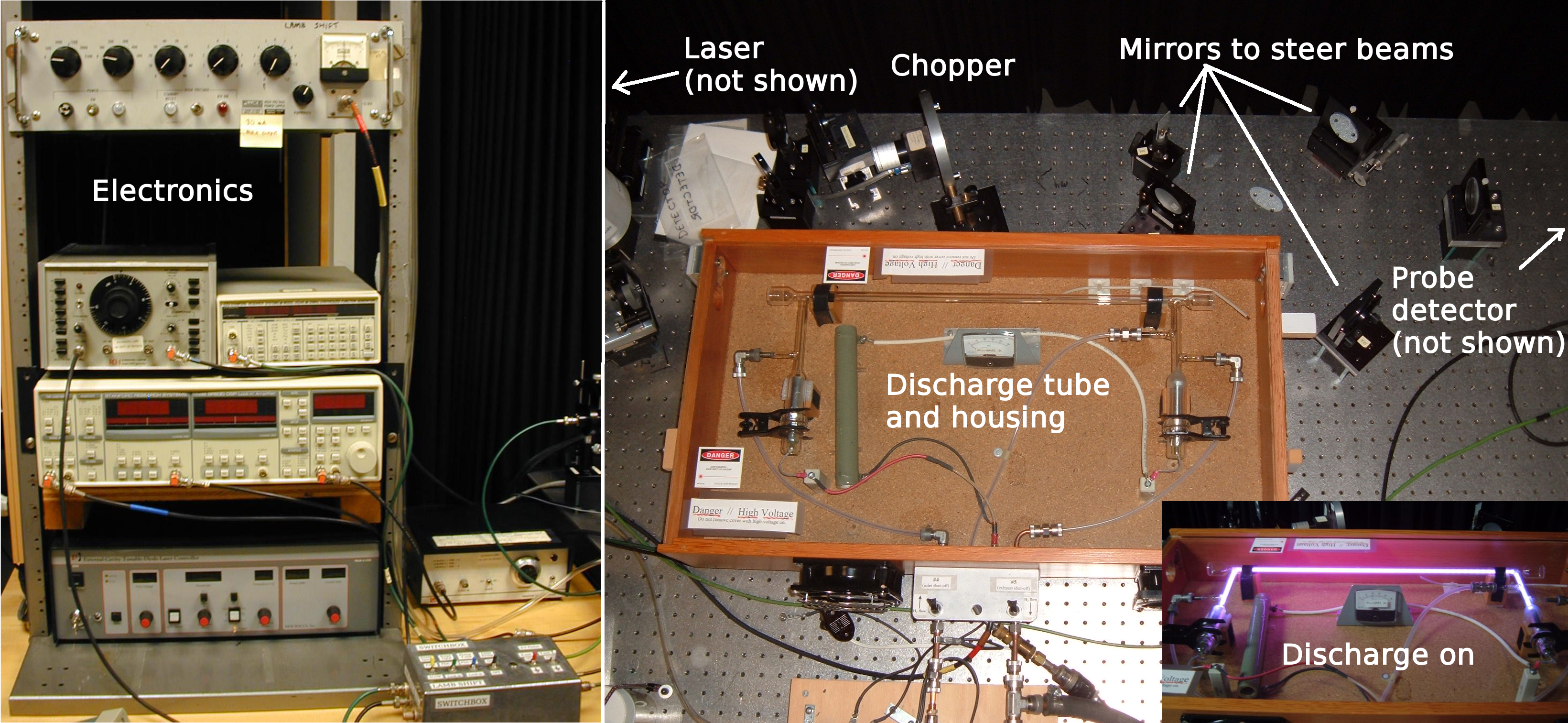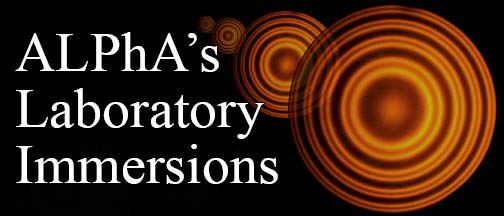- Home
- What We Do
- Laboratory Immersions
- Immersions 2018
- Imm2018Wash_HydrogenFineStructure
Hydrogen Fine Structure with Doppler-free Laser Absorption Spectroscopy
University of Washington, Seattle, July 6-8, 2018
With the development of tunable lasers, a new technique of absorption spectroscopy that allows the hydrogen fine structure to be observed directly became possible. This technique uses crossed beams, with each beam traveling in opposite directions through a gas discharge tube filled with glowing hydrogen. Only those atoms that have zero velocity along the beam axis can interact with both beams, and this causes the signal from one of the beams to show a small Doppler-free feature on top of the Doppler-broadened spectrum. By chopping the other beam, and thus turning such features on and off, one can selectively amplify these small features, and obtain a Doppler-free spectrum.
In this immersion, participants will learn this technique of crossed-beam Doppler-free absorption spectroscopy, and use it to measure the fine structure of the Balmer-α line (at 656.28 nm), and in so doing measure the Lamb shift. Thus, this experiment gives one the opportunity to learn an experimental technique that is in current use in many research laboratories, and also to measure one of the most important experimental results that support modern quantum electrodynamics, arguably the king of 20th century physical theories for its success in explaining the hydrogen spectrum to extraordinary precision.
This experiment uses the most complex and specialized setup we have in the undergraduate laboratories. At its center is the gas discharge absorption cell and housing box. The absorption cell is custom built by our glassblower and allows laser beams to pass along about a 50 cm length occupied by a glowing hydrogen discharge. The tube and plumbing is designed to allow a continuous flow of hydrogen, and the gas is lit by a 2000 V DC supply. The laser is a New Focus model 6202 external-cavity diode laser acquired in 1999, specifically designed to scan through the Balmer-α line. A system of mirrors, lenses and a beam splitter are used to separate the laser beam into a bright "pump" beam and less intense "probe" beam, with each beam passing through the discharge tube in opposite directions. Finally the pump beam is chopped, and the synchronous signal is used to eliminate noise and background from the signals picked up by the probe beam detector and another detector at the output of a Fabry-Perot cavity. A dual-pen chart recorder captures the sweep signal from both detectors. By comparing the probe signal with the Fabry-Perot signal, an accurate measurement of the separation of spectral lines can be carried out. Signal generators and interconnecting boxes are used to rout signals and drive the laser sweep electronics. In the pictures below are shown the discharge tube and an overview of the optics layout, plus the equipment rack containing a lock-in amp, HV supply and signal generators. The inset at lower right shows the lamp in its "on" state.

Laser absorption spectroscopy is a current technique in active research. This experiment illustrates the technique extremely well and includes a vivid example of the power of lock-in amplification to separate signal from background. Among the experimental topics to be covered are understanding and using tunable external-cavity lasers, operating hydrogen gas-discharge absorption cells, layout and alignment of crossed-beam optics, measurements of frequency shift with Fabry-Perot cavities, and using optical choppers and lock-in amplification to extract tiny signals from a large background. Sufficient theory will also be studied to provide the participant with ways to teach the concepts to undergraduate physics students.
First steps: Run it like a student
Discussion — Review of the hydrogen spectrum and hydrogen fine structure; Predictions of the Dirac equation; attempts to measure fine structure and Lamb & Retherford's microwave experiment; the principles of laser absorption spectroscopy and the crossed-beam technique.
• Layout of the optical components. Details of the crossed-beam geometry.
• Construction of the gas discharge lamp.
• Creating hydrogen flow; purging the system.
• Lighting the lamp and adjusting the pressure. What to look for in a good discharge.
• Tuning the laser and finding the Balmer line.
• Seeing "hole burning" and the Doppler-free spectral peaks.
• Operating the lock-in and chopper; optimizing lock-in tuning.
• The Fabry-Perot: how it works.
• Collecting scans; thinking about laser frequency-shift hysteresis.
• Analyzing the data. "Crossover" resonances.
Take it apart
Disassemble and reassemble. How to approach setup and alignment of optics.
Challenges in beam alignment: pick-off mirrors and the Fabry-Perot.
The discharge tube; making and replacing electrodes; details of circuit.
Hydrogen generator versus hydrogen tank—a puzzle.
Deeper exploration
Discussion — What is a lock-in amplifier? Some common uses, and standard features of commercial lock-ins. How to make one yourself. Optimizing the settings. (Optional: an experiment to learn the principles of the lock-in from the ground up.)
Discussion — Descriptive and approximate versions of QED theory: Bethe's renomalization and Welton's interpretation. Additional contributions to the Lamb shift.
Extension: looking for hyperfine splitting
Extension: exploring features of the hydrogen discharge
Build it at home?
Discussion — Implementation challenges: discharge tube and hydrogen source; laser.
Safety considerations — There are a few hazards in this experiment: a high-voltage power supply gas discharge lamp; UV radiation from discharge tube, hydrogen gas, and a medium-power (5-10 mW) laser (Class IIIb).
All essential materials and equipment will be provided, but participants are encouraged to bring a camera (cellphone OK) and computer/notebook to record notes and results. If the participant has a favorite data analysis package, that will be useful during the lab.
Safety considerations. There are a few hazards in this experiment: a high-voltage power supply gas discharge lamp; UV radiation from discharge tube, hydrogen gas, and a medium-power (5-10 mW) laser (Class IIIb). Instruction will be provided concerning these risks.
As noted, this experiment is one of the most advanced in our department, and the components are not cheap or simple to obtain. Our setup was mostly completed in 2000, so the following prices are at best a rough guide.
- Optical table (4'x6') [Thorlabs T46H]: $3700
- Flat surface mirrors, a beamsplitter, lenses, and adjustable mounts [Thorlabs, various] about $2000
- 2 diode detectors and pinholes, with mounts [Thorlabs SM1PD1A]: $400
- Gas discharge tube with optical ports & housing (custom built): Estimate $1000-$2000
- Tunable diode laser with range that overlaps Balmer-α line (656.3 nm) [New Focus]: $20,000
- Fabry-Perot set (a fixed etalon is OK, need about 10 cm mirror spacing or about 1000 MHz free spectral range) [Thorlabs SA200-5B]: $2800
- HV supply for discharge lamp (nominally up to 2.5kV and 25 mA) [Acopian P02.5HP24]: $1250
- Digital function generator (for sweep) [SRS DS335] $1400
- Two lock-in amplifiers [SRS SR510]: 2 x $2500
- Optical chopper [SRS SR540]: $1200
- Hydrogen source and gas handling plumbing (custom, parts from Swagelok): about $500
- Vacuum pump: [various possibilities]: about $1000
- X-Y recording device and/or oscilloscope: about $1000

David Pengra, after a short career as an electric equipment repairman and radio engineer, received his PhD in condensed matter experimental physics at the University of Washington in 1991, working under Greg Dash on the thermodynamics of low-temperature adsorbed films. He then completed two post-docs, the first with Jakob Bohr in Denmark on resonant magnetic x-ray diffraction from rare-earth crystals, and the second with Po-zen Wong at the University of Massachusetts, Amherst, on electrokinetics and fluid flow in porous media. He joined the faculty of Ohio Wesleyan University in 1996, where he continued his work in porous media and taught physics, specializing in advanced laboratory courses and electronics. David returned to the University of Washington in 2003, where he teaches laboratory courses at all levels and manages the department's advanced teaching laboratories, which include courses in analog and digital electronics, computer interfacing, optics, condensed matter physics, atomic and molecular physics, and nuclear and particle physics. During his time at Washington, he has also been deeply involved in revising the laboratory curriculum for the introductory physics sequence. David enjoys the wide range of physics he gets to think about and teach in the laboratory courses, and he especially likes to help students learn the skills, craft and techniques of experimental physics.
David B. Pengra, Senior Lecturer in Physics / Advanced Labs Manager, University of Washington, Department of Physics, Physics/Astronomy Building, Box 351560, University of Washington, Seattle, WA 98196-1560. Email: dbpengra@uw.edu. Phone: (206) 543-4783.
Please note that the Jonathan F. Reichert Foundation has established a grant program to help purchase apparatus used in Laboratory Immersions. Limitations and exclusions apply, but generally speaking the foundation may support up to 40% of the cost of the required equipment.






